Welcome to our comprehensive guide on optimizing date palm orchard operations. Whether you’re a seasoned date palm farmer or a beginner looking to venture into date palm cultivation, this blog post will provide valuable insights and month-wise planning tips to ensure successful and efficient orchard management.
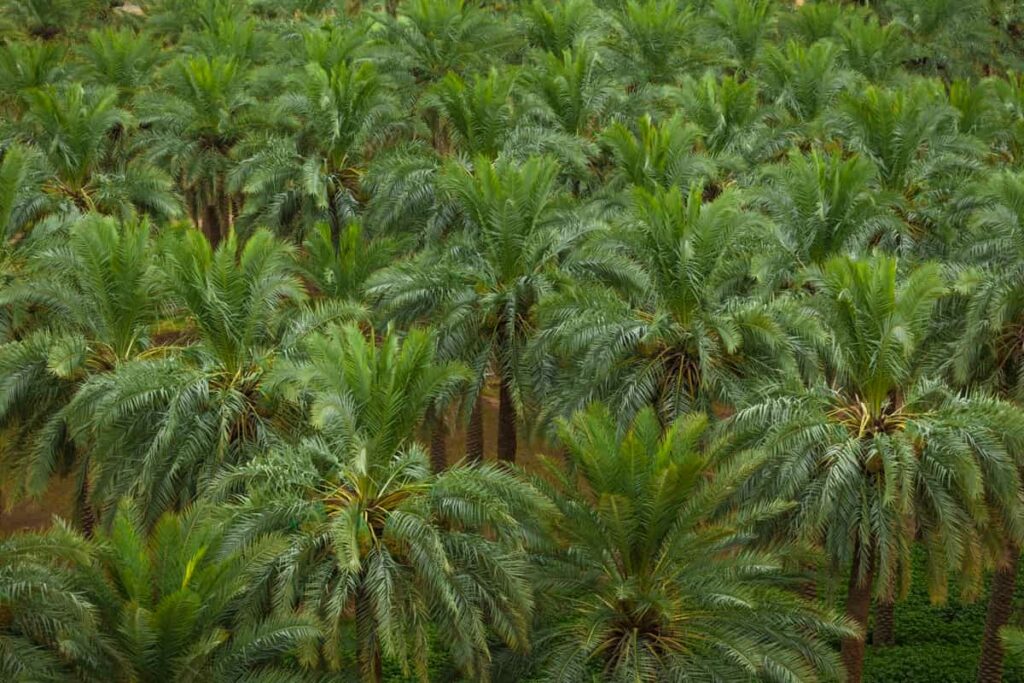
Date Palm Orchard Management
What is Date Palm Farming and its Overview?
Date palm farming, scientifically known as Phoenix dactylifera, is a popular agricultural practice for cultivating delicious and nutritious fruit called dates. This flowering plant belongs to the palm family. It is cultivated extensively in regions across Africa, the Middle East, and South Asia, with its cultivation spreading to tropical and subtropical areas worldwide. Date palm trees are remarkable, reaching heights of up to 30m (100 feet), and can live for over a century when well-maintained.
The fruit, known as dates, are oval-cylindrical in shape, measuring 3 to 7 centimeters (1 to 3 inches) in length and about 2.5 cm (1 inch) in diameter. The color of dates varies from dark brown to bright red or yellow, depending on the variety. When dried, dates contain a high sugar content of 61-68% by mass, making them incredibly sweet and commonly enjoyed as standalone treats or incorporated into various desserts.
Date palms are dioecious, meaning they have separate male and female plants. While they can be grown from seeds, only around 50% of seedlings must be female and capable of bearing fruit. Moreover, dates from plants are often smaller and of lower quality. Commercial plantations primarily use cuttings from high-yielding cultivars, as plants grown from cuttings will bear fruit 2-3 years earlier than seedlings.
In traditional and commercial orchards, date palms are hand-pollinated to ensure optimal fruit production. Male plants serve solely as pollinators and are pruned in favor of female plants that produce the desirable fruit. Skilled laborers manually perform pollination, often using ladders or utilizing wind machines to assist in the process.
Best Tips for Growing Date Palm Orchard Operations Practices
Climate Required: Date palms thrive in a long summer, warm winter, and plenty of sunlight. They prefer low relative humidity and no rain during flowering and fruiting. Wild dates can be found at altitudes of up to 1500 meters. The ideal temperature for flowering and fruiting is above 70 degrees Fahrenheit, with a month-long period above 80 degrees Fahrenheit for proper ripening.
In case you missed it: Optimizing Cashew Orchard Management: A Month-by-Month Operation Guide for Maximum Yield
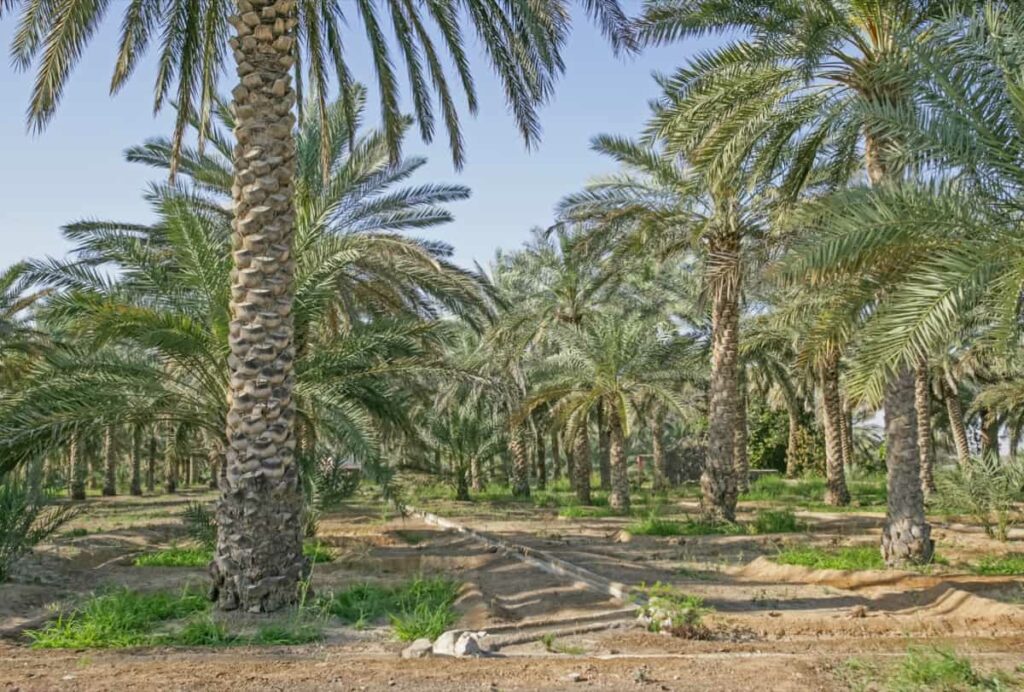
Soil Required: Date palms can grow in a differnt range of soils but perform best in sandy loam and well-drained soils with a pH of 8-10. While they can tolerate saline and alkaline soils, growth and yield may be affected. Ensuring the absence of a hardpan below the 60-90cm range is crucial for root development.
Mode of Propagation: The most common propagation method is through offshoots or suckers. These are separated from the mother tree base after 4-5 years and can produce 9-20 suckers weighing 9-15 kg between the 4th and 10th years. Seed propagation is avoided due to poor fruit quality and the possibility of non-bearing males. Tissue culture is another technique for rapid multiplication.
Sowing Process: Soil preparation involves plowing the soil multiple times and creating pits of 1m x 1m x 1m during summer. After 15 days, the pits are filled with well-rotted farmyard manure (FYM) and soil. Plantation is typically done in February and March, taking advantage of the hot summer months. However, in certain regions like Kutch in India, plantation begins at the monsoon’s beginning. The offshoots are planted 6–7 meters apart in 1 x 1 x 1 m holes soon after detachment. This allows 202–275 plants/hectare.
Irrigation Requirement: Immediate irrigation after plantation is crucial, but drought and over-irrigation can be detrimental. Date palms prefer steady soil moisture levels, avoiding waterlogged conditions. During the monsoon, irrigation may not be necessary, but drainage is essential during floods. Mulching with dried leaves and grasses helps retain soil moisture.
Intercropping: Date palm orchards offer opportunities for intercropping with pulses, vegetables, pomegranates, or papaya. Additional irrigation and nutrient management should be considered for successful intercropping.
Pruning: Pruning is necessary to maintain adequate green leaves for optimal growth and harvest. Around 75-100 leaves are recommended during the bearing stage. No pruning is required in the first 4-5 years when the tree produces fewer leaves annually. Maintaining the appropriate leaf bunch ratio is essential to improve fruit quality and avoid diseases like Blacknose.
Pollination: Date palm trees are dioecious and heavily cross-pollinated. Only a small percentage of male plants are needed to pollinate more female plants. Hand or machine pollination is commonly practiced in commercial orchards, with three male flower strands inserted into each female flower strand.
Flowering and Fruiting in Date Palm Trees: Hand pollination is required as they are dioecious. Female palms bear 6 to 12 clusters with 50-100 strands and 16-30 set fruits each. Pollination is done by dusting the female flowers with pollen and placing male inflorescence strands inside. The fruit goes through four stages: Kimri (gandora), Khalal (doka), Rutab (dang), and Tamar (pind), with Tamar being the fully mature stage equivalent to raisins in grapes.
In case you missed it: Date Palm Cultivation in Karnataka: A Step-By-Step Guide to Planting to Harvesting for Beginners
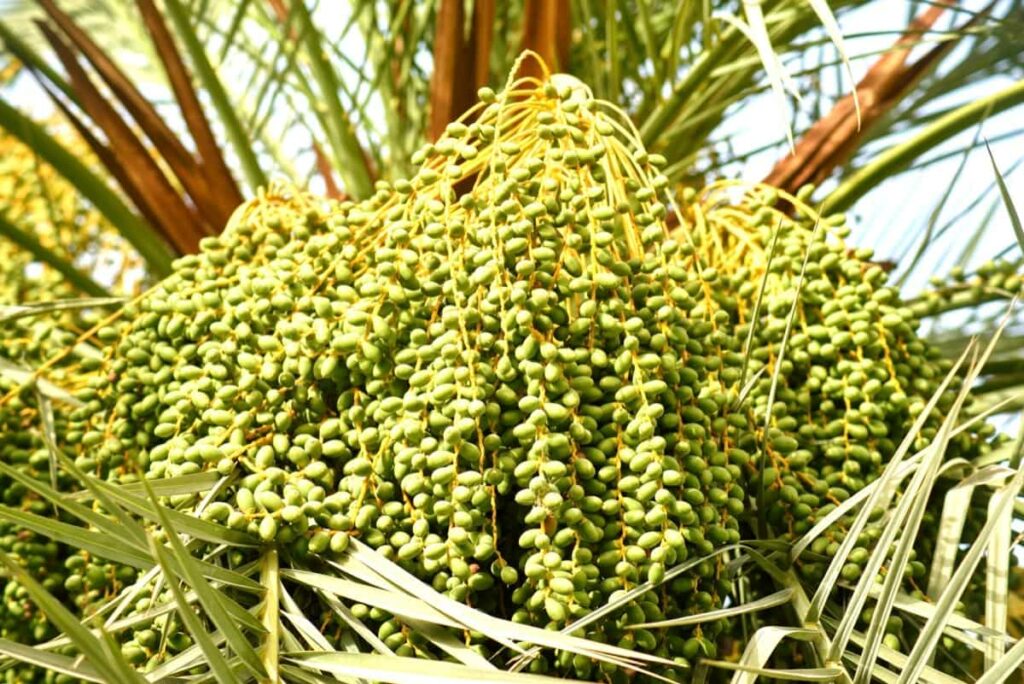
Fertilizers: Fertilizer requirements vary based on water availability. For rainfed areas, 30-40 kg FYM and 200 g each of Nitrogen, Phosphorus, and Potassium (NPK) per tree are recommended. For irrigated areas, 50-60 kg FYM and 200 g of NPK per tree are suggested. Split applications of fertilizers are beneficial, with the remaining half of nitrogen applied in January-February.
- Farmers rarely manure date palms. Manuring boosts tree growth. Research recommends 25–50 kg of farmyard manure and 1–2 kilogram of ammonium sulfate per palm.
- Leguminous crops in the date palm may diminish amounts. Farmyard manure is applied from December–January. In early February, deliver the nitrogen dose.
- To produce more, a full-grown date palm tree needs 20-40 kg FYM, 500-1000 g N, 250-500 g P2O5, and K2O yearly. Apply farmyard manure in September–December following rainfall.
- Provide all phosphorus, potassium, and 60% nitrogen three weeks before flowering. Apply 40% nitrogen during fruit growth in March–April.
Pest & Diseases: Date palm orchards can be affected by pests like black-headed caterpillars, red weevils, rhinoceros beetles, scale insects, and birds. Common diseases include False Smut/Graphiola Leaf Spot and other fungal infections. Proper pest and disease management is crucial, including using fungicides and Bordeaux mixture as preventive measures.
Harvesting: Dates can be harvested at different stages of ripening, depending on their intended use. The stages include Gandora or Kimri (green and still growing), Dora or Khalal (full-sized and changed color), Dang or Rutab (softening at the tip), and Pind or Tamar (fully mature and dry for storage). Each stage offers different flavors and textures for consumption.
Yield: Date palms typically start bearing fruit from the 4th year, with good yields expected from the 5th year onward. The average yield varies depending on variety, soil quality, cultivation practices, and growing area. A 10-year-old tree can yield 50-60 kg of fruits yearly, while a 15-year-old tree can yield 80-200 kg yearly.
Storage: Dates harvested at the Khalal stage, with high water content, have poor keeping quality at room temperature. Storing dates in a cool environment is recommended to maintain freshness and crunchiness. However, dates should be sold as quickly as possible for better marketability.
January Month Date Palm Orchard Operations Planning
- Place irrigation supports and connect micro-jets or drippers.
- Mix well-matured manure, gypsum (if needed), and NPK fertilizers with the soil.
- Start the irrigation cycle to allow the soil to settle.
- Fertilize at planting with specific amounts of organic material and fertilizers.
- Apply organic material (manure, maize hay, wheat straw, etc.) into the holes prepared in December. Use approximately 2-3 kg of organic material per hole.
- Mix the organic material with the soil in the hole and create a mound in the center.
- Plant the selected tree species in the center of each mound. Ensure the tree is planted at the same depth as in the nursery.
- Backfill the pits with soil, firming it gently around the tree’s base.
- Install the micro sprayer supports around each tree at a rate of 3 per plant. These supports will hold the micro sprayers for irrigation.
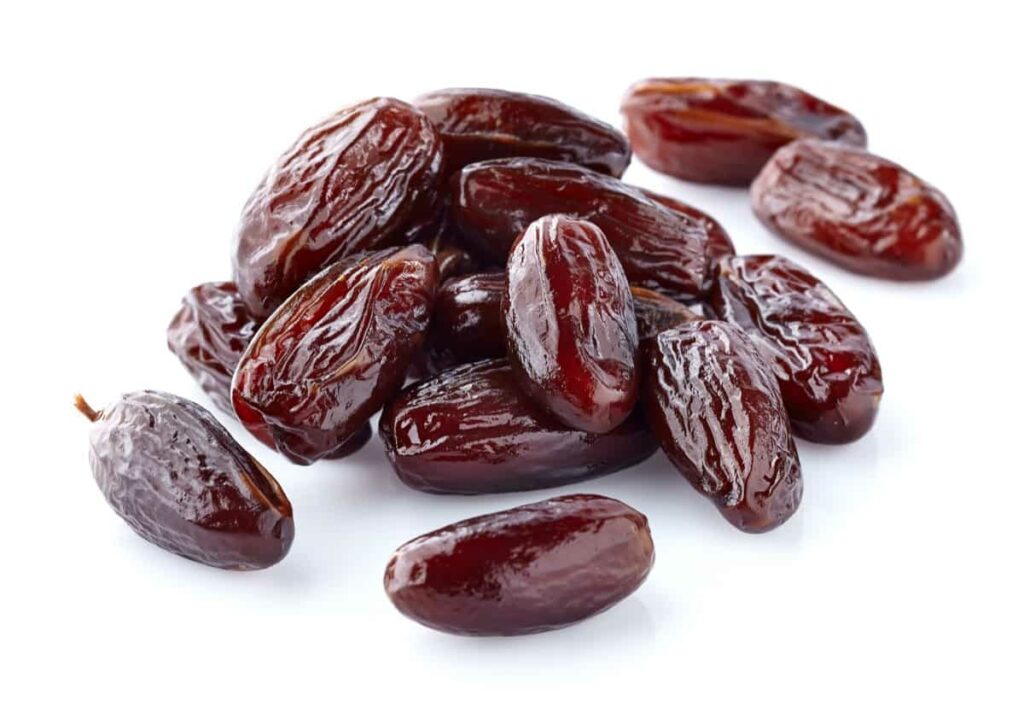
February Month Date Palm Orchard Operations Planning
- Select planting material at the nursery with at least four pinnae leaves.
- If necessary, apply appropriate fertilizers or soil amendments based on soil tests and tree requirements.
- Prune any damaged or diseased branches to promote healthy growth.
- Keep weeds under control by manual removal or mulching around the trees.
- Inspect plants for diseases and pests.
- Review and ensure identification of each plant.
- Label each block, row, and line.
- Apply a specific fertilization program for tissue culture plants.
- Irrigate plants with a specific solution until transplanting.
March Month Date Palm Orchard Operations Planning
- Plant date palm seedlings early in the morning.
- Irrigate immediately after transplanting.
- Maintain moisture in the soil through light and frequent irrigation.
- Monitor the irrigation cycle and check micro-jets or drippers.
- Avoid leaf pruning during the first two years.
- Plant male palms separately for pollination.
- Implement proper weeding practices.
- Apply additional fertilizers or soil amendments as recommended based on tree requirements.
- Prune the trees to shape them and promote desired branching structure.
- Follow the recommended spacing of 10 meters between rows and 8 meters between palms in a row, resulting in 125 palms per hectare planting density.
- Build a basin with a 1.5 to 1.8 meters diameter and a depth of 20 to 30 centimeters around each palm. Mulch the basin with hay or wheat straw.
- Monitor for insect pests and diseases and take appropriate actions for control.
- Maintain weed control measures.
April Month Date Palm Orchard Operations Planning
- Clean palms by removing old fruit stalks, leaves touching the ground, and young offshoots.
- Apply specific fertilizers and leaching if required.
- Weed and mulch the palm’s basin.
- Attend general maintenance practices.
- Apply fertilizers or soil amendments as needed based on tree requirements.
- Prune the trees to remove any dead, damaged, or crossing branches.
In case you missed it: Optimizing Fig/Anjeer Orchard Management: A Month-by-Month Operation Guide for Maximum Yield
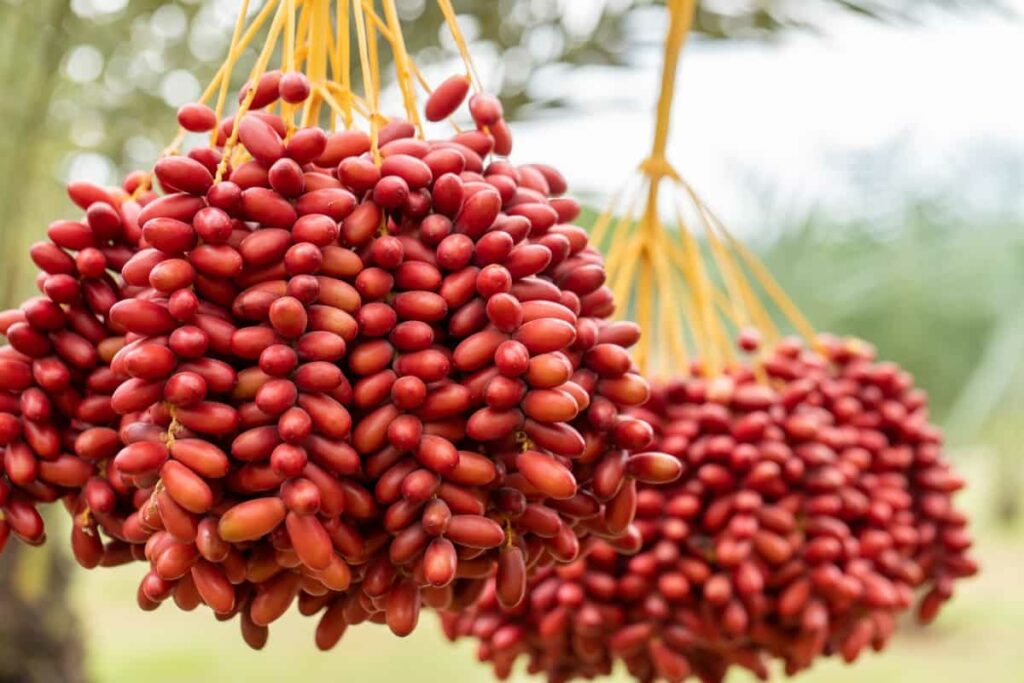
May Month Date Palm Orchard Operations Planning
- Apply additional potassium chloride fertilizer.
- Assess the survival rate of seedlings.
June Month Date Palm Orchard Operations Planning
- Apply additional ammonium sulfate fertilizer.
- Harvest pollen from male palms if they start production.
- Monitor and implement a control program against pests and diseases.
July Month Date Palm Orchard Operations Planning
- Remove offshoots from palm trees.
- Start the technical calendar for date palm plantations older than 4/5 years.
- Remove offshoots from the palm trees. This should be done two times a year, in July and December. Ensure that the attachment point between the offshoot and the mother plant is treated with copper oxychloride.
- Implement weed control measures to keep the plantation area free from competing vegetation.
- Clean palms, remove spines and prepare for pollination.
- Apply fertilizers according to the schedule.
- Monitor irrigation, weeding, and general maintenance.
August Month Date Palm Orchard Operations Planning
- Continue pollination until the end of August.
- Assess fruit set and perform necessary leaf pruning.
- Initiate marketing and logistical planning.
- Apply ammonium sulfate fertilizer.
September Month Date Palm Orchard Operations Planning
- Remove excess fruit bunches per palm.
- Thin bunches from the inside to maintain fruit distribution.
- Position and support the remaining bunches with ropes.
- Implement specific thinning techniques for each variety.
- Ensure proper fruit distribution and weight.
October Month Date Palm Orchard Operations Planning
- Continue to monitor the growth of the palm trees. Address any issues promptly to ensure their well-being.
- Adjust the irrigation schedule as needed to provide adequate moisture for the palm trees.
- Implement weed control measures to maintain a weed-free plantation area.
- Evaluate the overall performance of the palm trees and assess their progress toward fruit production.
November Month Date Palm Orchard Operations Planning
- Monitor the palm trees for signs of pests, diseases, or nutrient deficiencies. Take appropriate actions for control or supplementation.
- Adjust the irrigation based on weather conditions and the water requirements of the palm trees.
- Continue with weed control activities to minimize competition.
- Prepare for the upcoming fruiting season by ensuring that the palm trees are well-maintained and healthy.
December Month Date Palm Orchard Operations Planning
- Remove offshoots from the palm trees to promote vigorous growth and early fruit production. Treat the attachment point with copper oxychloride.
- Monitor the health and growth of the palm trees and address any issues promptly.
- Maintain regular irrigation and adjust as necessary based on weather conditions and the water needs of the palm trees.
- Continue weed control measures to keep the plantation area free from competing vegetation.
- Evaluate the progress of the palm trees toward fruit production and make any necessary adjustments to the care and management practices.
In case you missed it: Optimizing Papaya Orchard Management: A Month-by-Month Operations Guide for Maximum Yield
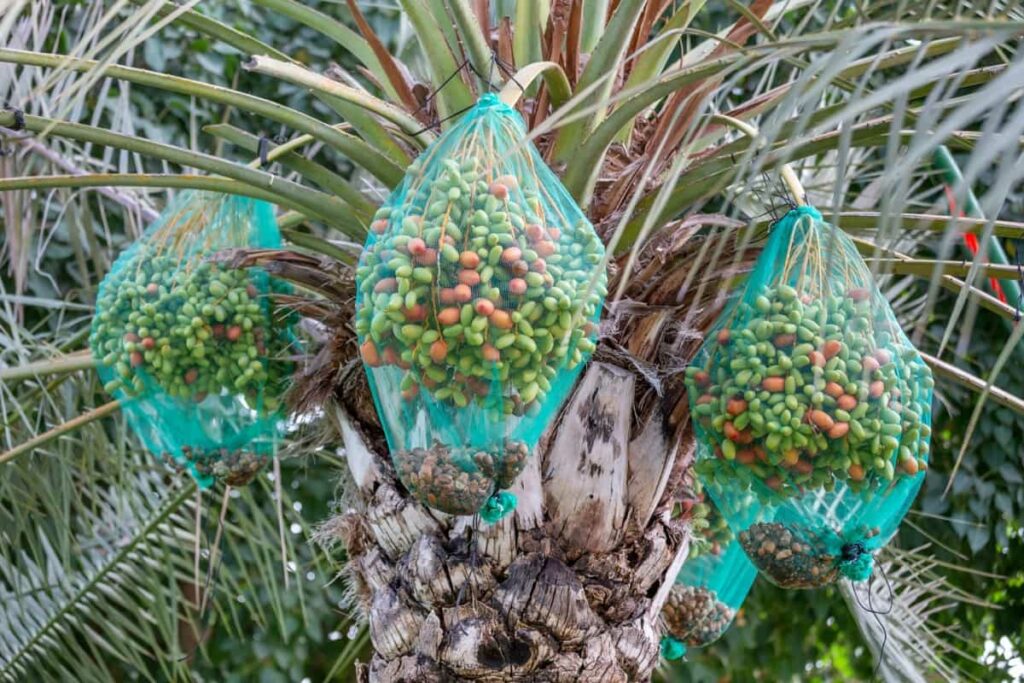
Conclusion
This comprehensive guide provides a month-by-month plan for optimizing date palm orchard operations. Following the suggested activities, such as planting, irrigation, pollination, and fruit development, growers can ensure efficient management and maximize productivity in their date palm orchards.
- Management Pests and Diseases in Your Cotton Field
- Sheep Farming Business Plan for Beginners
- Aquaponic Farming at Home: A Step-By-Step Guide
- Profitable Village Farming Business Ideas in 2024
- High-Yield Aquaculture: Fast-Growing Fish for Farming
- Effective Fish Pond Construction Techniques for Beginners
- Irrigation and Water Management in Pineapple Farming
- Blossom to Harvest: Mastering Flowering and Pollination in Papaya Farming
- Pig Fattening Essentials: From Selection to Sale for Beginners
- Raising Wagyu Cattle: A Complete Guide for Premium Beef Production
- Soil Types and Their Water Holding Capacity
- Optimizing Irrigation Schedules for Coconut Groves for Enhanced Yield
- Espresso Your Garden: Coffee Grounds for Healthier Acid-Loving Plants
- The Best Soil Mix for Snake Plants: How to Mix Your Own Snake Plant Soil
- Green Thumb Success: Expert Tips for Cultivating Greenhouse Beans All Year Round
- Bloom All Year Round: The Ultimate Guide to Indoor Hyacinth Care
- Eco-Friendly Gardening: How to Make Liquid Fertilizer from Kitchen Waste
- Ultimate Guide to Grow Anise in Pots: Explore Seed Propagation to Harvesting
- Guide to Raising Chester White Pigs: Discover Breed Facts to Growth Management
- Mastering the Elegance: The Ultimate Guide to Weeping Cherry Tree Care, Planting, and Maintenance
- Ultimate Guide to Planting Garlic in Grow Bags: Growing Strategies for Beginners
- How to Fix Spider Plant Leaf-Related Problems: Natural and Organic Remedies
- 10 Reasons Why Your Tulsi Plant is Shedding Leaves: Home Remedies and Solutions
- Optimizing Growth and Yield: The Advantages of Palm Bunch Ash Fertilizer
- Utilizing Neem Oil Extract as a Natural Pesticide for Hydrangea
- From Soil to Harvest: Various Ways in Which Farmers Can Use AI Tools
- Steps to Encourage and Induce Citrus Flowers: A Comprehensive Guide
- How to Fix Snake Plant Leaf-Related Issues: Natural and Organic Remedies
- Transform Your Garden into a Fragrant Oasis with Raat Ki Rani (Night Blooming Jasmine)
- Discover the Ideal Chicken Breeds for Philippine Farms
- How to Create a Poultry Egg Farm Business Plan for Profits
- Grow Lemon Cucumbers Like a Pro: Insider Techniques for Bountiful Yields
- Ultimate Guide to Caring for Your Pink Princess Philodendron: Tips for Thriving Variegation
- Areca Nut Profit Per Acre: Calculating Yield and Cost of Cultivation
- How Kaveri Chicken is Becoming a More Profitable Breed in Indian Backyards
- Transform Your Barn: 9 Steps to Convert a Horse Stall into a Chicken Coop
